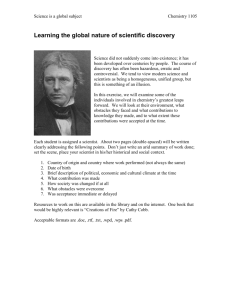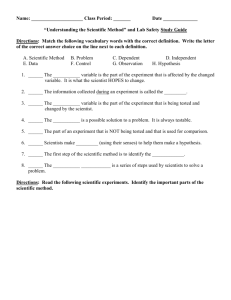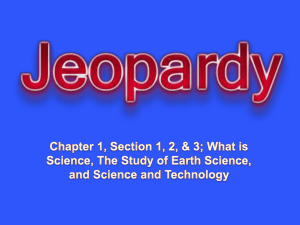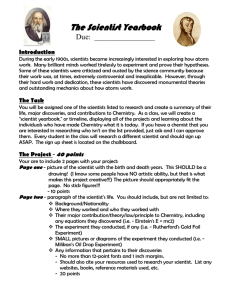Science Review for Chapter 1
advertisement
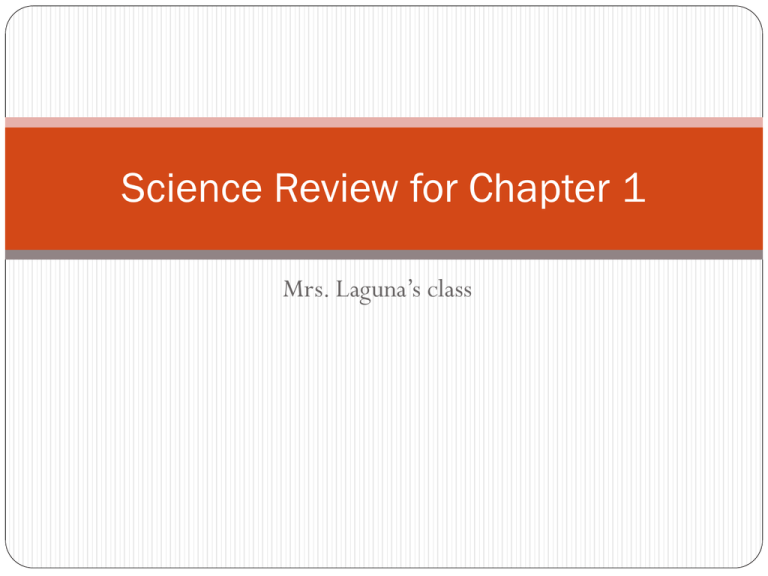
Science Review for Chapter 1 Mrs. Laguna’s class Table of Contents Lab Equipment Review Terms Section 1 Review Section 2 Review Section 3 Review Section 4 Review You cannot skip ahead to a specific page. Sorry!!!! Lab Equipment How we will play, is you will receive a picture of a piece of lab equipment and you are given the name or what it does. Then, you have to fill in the blank… What is this piece of equipment? This piece of equipment is used for calculating the weight or force of an object in Newton… SPRING SCALE!! A Triple Beam Balance What is a triple beam balance used for??? A triple beam balance is used for measuring an objects mass (g) A Test Tube What is a test tube used for?? Holding small amounts of liquids or chemicals What is this piece of lab equipment? It is used for holding and mixing liquids and chemicals. FLASK!!!!! What is this piece of lab equipment? It is used for measuring length and height (cm). RULER!!!!! A Graduated cylinder What is this lab equipment used for? Measuring liquids (mL) What is this lab equipment? It is used for measuring and dispensing small amounts of liquid. PIPETTE!! A Lab Scoop/ Spatula What is it used for? Scooping chemicals and powders What is this lab equipment? It is used for holding or heating liquids. BEAKER!!! A Test Tube Tongs What is it used for??? Holding test tubes Section Terms These are terms (bolded and colored words) from your textbook that were stated in the beginning of each section. Hope you payed attention…. Physical Science The study of matter and energy. It is split into two categories known as Physics and Chemistry. Scientific Method A series of steps that scientists use to answer questions and solve problems. Theory A unifying explanation for a broad range of hypotheses and observations that have been supported by testing. Technology The application of knowledge, tools, and materials, to solve, problems and accomplish tasks; technology can also refer to the objects used to accomplish tasks. Observations Any use of the senses to gather information. Model A representation of an object or system. Law A summary of many experimental results and observations; a law tells how things work. Density The amount of matter in a given space; mass per unit volume. D=m/V Hypothesis A possible explanation or answer to a question. Area A measure of how much surface an object has. Meter The basic unit of length in the SI system. (m) Data Any pieces of information acquired through experimenta tion. Volume The amount of space that something occupies or the amount of space that something contains. Temperature A measure of how hot (or cold) something is; specifically, a measure of the average kinetic energy of the particles in an object. Mass The amount of matter that something is made of. Section 1 Exploring Physical Science What did Czarnowski and Triantafyllou create? What part of nature inspired this idea? They created a boat known as the Proteus. It had two broad paddles and two car batteries. The Proteus was designed after a penguin and the paddles were suppose to move like the penguins flippers. What is physical science? What 2 categories split physical science? Physical science is the study of matter and energy. It is split into Physics and Chemistry. What purpose do models serve? To demonstrate an idea, event, or object. Represent an object or system. Business: graph’s, tables, charts, etc. Students/ Teachers: demonstrations- atoms, space, particles, etc. Physics or Chemistry When you move right and your car is turning left. Physics Pollution affecting the atmosphere Chemistry Rainbows after a rainstorm Physics Dirty clothes becoming clean Chemistry Why water boils at 100 degrees Celsius Chemistry Energy+ Matter= Physical Science p. 7 What do a ball, air, and a cheetah have in common? They are made up of matter and they also have energy. Moving objects have energy. Do non-moving objects have energy? Yes Section 2 Using the Scientific Method True or False Advancements in science are mostly due to luck. False Scientists usually ask a question before they make any observations. False Scientific laws are determined by nature. True A scientific law is a summary of many experimental results and observations. True Laws tell you why something happens, not what happens. True You could be arrested if you break a scientific law. False What is the Scientific Method? Scientist use the scientific method to…. Ask questions Solve problems by following a series of steps Hypothesis A hypothesis is… Usually stated in an “if…then…” format What is a hypothesis? A possible explanation or answer of a question Analyzing, Conclusions, and Communicating Results Analysis of results means doing what with the data? organizing What are 3 ways that communicating results can help other scientists further scientific research? Scientists can- based on your results- study a new problem, conduct their own test, or even try to learn something more specific by modifying your test. What is ALWAYS true for scientific investigations? Scientist take accurate measurements and accurately record data. Building Scientific Knowledge An idea that is supported by many tests and experiments can become what (2 things)? A theory or a law What is NOT true about a scientific theory? It is a simple guess Section 3 Using Models in Physical Science True or False When we picture things in our minds, we are creating models. True What did the MIT engineers hope to gain from making a model? They hoped to gain more knowledge and a greater understanding about a boats propulsion. What is a model? Something that can represent or . Systems or Objects What are some ways to use models in science? looking at the tiny parts of a microscopic cell on a cell diagram, testing a new design for a building on a computer before spending the money on construction, launching a homemade rocket in your backyard, observing how the parts of matter fit together without being able to see the tiny particles, etc. Models Help You Visualize Information How could using the spring toy as a model help you understand the behavior of sound waves? It helps you understand the behavior of sound waves because it shows particle will crowd together- form a group- in certain parts of the sound wave. Models are Just the Right Size/ Models Build Scientific Knowledge Models can be used as to illustrate and investigations. Scientific ideas/objects, theories, conduct Object Smaller or Larger Mount Everest Smaller A computer chip Larger The moon Smaller A skyscraper Smaller A mosquito Larger Now come up with 2 or 3 examples of when the model would be larger and when the model would be smaller. Models can Save Time and Money How can cyber- crashes save time and money? It can save time because you can find out in the cybercrash what part of the car should be fixed before building it and wasting money adding something that’ll just be removed later. Section 4 Measurement and Safety in Physical Science Beginning/ The International System of Units Before you determine how many lenses will fit into a moving crate, what must you figure out? The volume of the crate and the volume of the lenses. At one time, systems of measurements were based on objects that varied in size, such as body parts and grains of barley. (true or false) TRUE Scientist can and their data when data are expressed in SI units. Share and compare What unit of measurement is most practical for measuring a house? Meters (m) The is the SI unit for temperature, but scientist often use degrees Celsius. Kelvin (K) Derived Quantities What are the 2 kinds of derived quantities? Area and Density Descriptions Sharp Objects Hand Safety Animal Safety Plant Safety Eye Protection Chemical Safety What image goes with each description. DO NOT PRESS THE SPACE BAR UNTIL YOU’VE ANSWERED ALL DESCRIPTIONS! Images A knife’s point A hand A frog in a hand A plant Goggles A poison bottle Heating Safety A flame Electrical Safety An outlet plug Clothing Safety A cooking apron Good Job!! You’ve completed the Review! Now that you’ve finished the review, go back in your book and look over the section so then you can remember what you read earlier.
